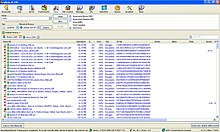
Back اسم ملف Arabic Faylın adı Azerbaijani Jméno souboru Czech Filnavn Danish Dateiname German Dosiernomo Esperanto Nombre de archivo Spanish نام پرونده (رایانه) Persian Nama berkas ID Skráarnafn Icelandic


A filename or file name is a name used to uniquely identify a computer file in a file system. Different file systems impose different restrictions on filename lengths.
A filename may (depending on the file system) include:
- name – base name of the file
- extension – may indicate the format of the file (e.g.
.txtfor plain text,.pdffor Portable Document Format,.datfor unspecified binary data, etc.)
The components required to identify a file by utilities and applications varies across operating systems, as does the syntax and format for a valid filename.
The characters allowed in filenames depend on the file system. The letters A–Z and digits 0–9 are allowed by most file systems; many file systems support additional characters, such as the letters a–z, special characters, and other printable characters such as accented letters, symbols in non-Roman alphabets, and symbols in non-alphabetic scripts. Some file systems allow even unprintable characters, including Bell, Null, Return and Linefeed, to be part of a filename,[citation needed] although most utilities do not handle them well.
Filenames may include things like a revision or generation number of the file such as computer code, a numerical sequence number (widely used by digital cameras through the DCF standard), a date and time (widely used by smartphone camera software and for screenshots), and/or a comment such as the name of a subject or a location or any other text to facilitate the searching the files.
Some people use of the term filename when referring to a complete specification of device, subdirectories and filename such as the Windows C:\Program Files\Microsoft Games\Chess\Chess.exe. The filename in this case is Chess.exe. Some utilities have settings to suppress the extension as with MS Windows Explorer.[not verified in body]
© MMXXIII Rich X Search. We shall prevail. All rights reserved. Rich X Search